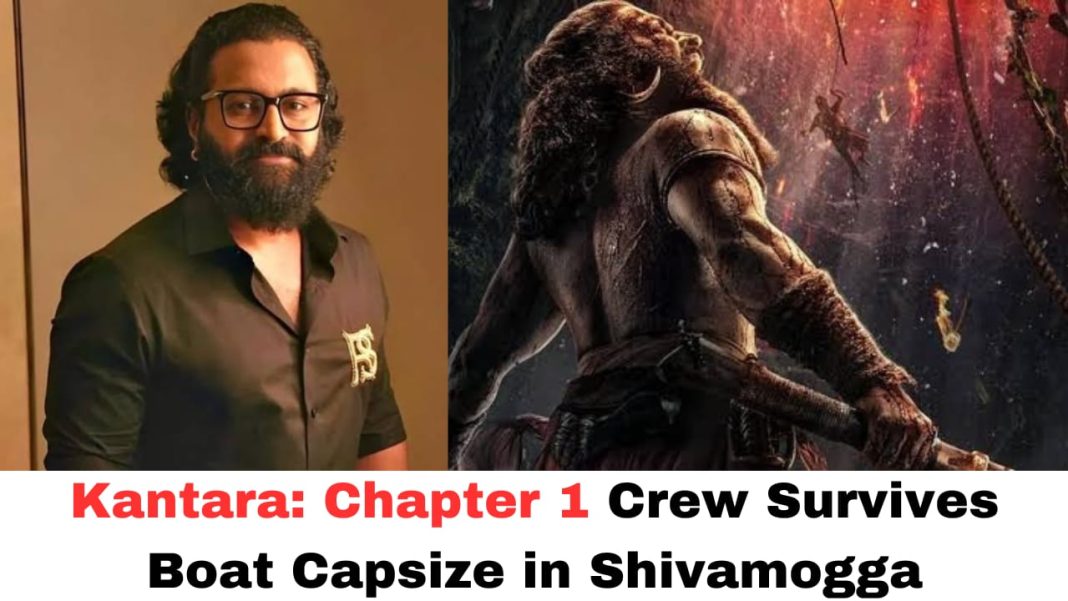Digita News guru Entertainment Desk:
Production for Kantara: Chapter 1 was interrupted by a tense and sudden accident. A small boat carrying actor-director Rishab Shetty and about 30 crew members capsized in the shallow but unpredictable waters of the Mani Reservoir. Remarkably, no one was injured in the mishap—a relief that stood in stark contrast to the scare it induced.
Kantara: Chapter 1 film crew’s boat mishap in Shivamogga
The mishap occurred during a shoot sequence in the Masti Katte area of Shivamogga, where a boat carrying key cast and crew tilted over and overturned. Fortunately, the boat was operating in relatively shallow water, allowing all onboard to swim to safety rapidly . Assistant crew members confirmed that standard safety measures—such as life jackets and rescue protocols—were in place, highlighting their vital role in averting disaster.

A History of On‑Set Accidents
This was not the first safety incident during filming. Earlier, a junior artist drowned in the Souparnika River near Kollur on May 6. The All Indian Cine Workers Association (AICWA) even demanded an investigation and a Rs 1 crore compensation, filing an FIR against Rishab Shetty and the production team. That tragic loss had forced authorities to pause filming and scrutinize safety protocols comprehensively.
Additional mishaps include a bus overturning while transporting crew members in November 2024 (though no injuries were reported), and mounting controversy over alleged environmental damage and disruption near forest areas where Kantara: Chapter 1 was being shot.
Safety Protocols Put to Test
Despite the fortunate outcome of the boat incident, the fact that the production has faced multiple mishaps—bus overturn, drowning, unexplained boat accident—has raised serious questions over the robustness of safety procedures.
Inside sources indicate that the team is now conducting a thorough internal audit of all safety protocols: re‑verifying life jacket quality, shore rescue readiness, and emergency drills for each water‑based scene. Though these steps remain internally referenced, fans and film safety watchdogs alike are urging the filmmakers to bring these measures into public view.
Production Halt & Operational Impact
Filming was temporarily paused following the capsize as the crew regrouped and equipment was inspected. A small break in shooting schedules is expected while the team confirms readiness to resume. No official public statements have been made yet, but insiders suggest Rishab Shetty himself is overseeing a rapid but rigorous review.
If delays extend, production costs may rise. However, given the high anticipation for Kantara: Chapter 1—a prequel to the blockbuster Kantara (2022)—and its planned October 2, 2025 release, the crew is likely motivated to strike a balance between safety and schedule adherence.

Crew Commentary & Culture
Crew members described the incident as a “blessing from the spirits,” expressing collective relief and team unity . Their quick action and adherence to safety procedures ensured no one was harmed, reinforcing the need to maintain these safeguards.
However, this accident—coupled with the cancelled drowning fatality and on-set controversies—highlights a pattern: the challenges of balancing ambitious outdoor shoots with the unpredictable elements of nature. For a film that features expansive war sequences and forest backdrops, such incidents raise concerns over risk management.
What Lies Ahead
- Safety Revamp:
An immediate, transparent overhaul of water-safety procedures is essential. Filmed night scenes near water, war sequences in dense terrains, and action-intensive stunts will all need stringent safety audits.
- Regulatory Oversight:
Given the AICWA’s involvement, there’s mounting pressure for external third-party inspections—especially for shoots involving boats, rivers, and forests. The May drowning incident already triggered an FIR; further scrutiny seems inevitable.
- Crew Well-Being:
The emotional toll of near-miss accidents must be acknowledged. Counseling and mental health support for crew members who experience trauma — whether from a drowning death or boat scare — should be prioritized.
- Environmental Ethics:
The forest damage allegations, especially regarding the use of explosives and unpermitted shooting zones, must also be addressed. Ongoing investigations by forest officials should shape future shooting choices and environmental safeguards.
Broader Industry Implications
The Kantara incidents aren’t isolated. Across India’s film landscape, remote and action-heavy shoots—on highways, railways, rivers, and mountains—are increasingly common. However, many sets lack formal institutionalized safety management.
The repeated incidents on this set may serve as a wake-up call, prompting the adoption of:
- Mandatory risk assessments before each dangerous sequence
- Contractual safety clauses binding production houses to standards
- Third-party supervision by recognized film-safety experts
- Crew awareness and empowerment to flag hazards
Industry bodies like the Film Statement for Safety initiative are expected to intensify efforts to elevate safety norms across regional and national film industries in India.

Closing Thoughts
The startling near-tragedy at Mani Reservoir—though ending in relief—highlights a critical issue for Indian filmmaking: ambition must never outpace safety. Rishab Shetty and Hombale Films now stand at a crossroads: they can lead by example, investing in rigorous safety structures and transparency, or risk further damage to reputation and crew morale.
With Kantara: Chapter 1 one of the nation’s most anticipated regional cinema releases, the stakes are high. If the team emerges with a reinforced safety culture, the film will likely be remembered not only for its storytelling and visuals, but also for setting a new benchmark for production welfare. But if incidents continue, questions of negligence and accountability will loom large.
You May Also Read: 5 Foreign Universities to Set Up in India, Receives Letters of Intent








